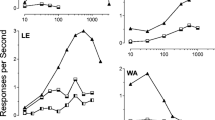Abstract
The behavioral effects of six methylxanthines were studied in squirrel monkeys responding under a fixed-interval (FI) schedule of stimulus-shock termination. Dose-response curves were determined for each drug by administering cumulative doses IV during timeout periods that preceded sequential components of the FI schedule. Low to intermediate doses of caffeine, theophylline, 8-phenyltheophylline (8-PT), 8-cyclopentyltheophylline (CPT), and 3-isobutyl-1-methylxanthine (IBMX) produced dose-related increases in response rate, whereas higher doses increased response rate less or decreased it. Enprofylline did not increase response rate at any dose. Pretreatment with a high dose of the adenosine agonist 5′-N-ethylcarboxamide adenosine (NECA) suppressed responding throughout the experimental session. Caffeine, theophylline, 8-PT, CPT, and IBMX, but not enprofylline, antagonized the suppressant effects of NECA in a dose-related manner. The potencies of the methylxanthines for increasing response rate under the FI schedule were positively correlated with their potencies for antagonizing the suppressant effects of NECA, suggesting that the psychomotor stimulant effects of methylxanthines are linked to their antagonistic actions at adenosine recognition sites. CPT, which in vitro has much higher affinity (>103-fold) than caffeine for adenosine A1, but not for A2, recognition sites, was only 3–6 times more potent than caffeine in increasing response rate or in antagonizing the effects of NECA. The psychomotor stimulant effects of methylxanthines therefore appear to be more closely associated with antagonism at adenosine A2 than adenosine A1 recognition sites.
Similar content being viewed by others
References
Bergstrand H (1985) Xanthines as phosphodiesterase inhibitors. In: Andersson K-E, Persson CGA (eds) Antiasthma xanthines and adenosine. Excerpta Medica, Amsterdam, pp 16–20
Bruns RF, Daly JW, Snyder SH (1980) Adenosine receptors in brain membranes: binding of N6-cyclohexyl[3H] adenosine and 1,3-diethyl-8-[3H]-phenylxanthine. Proc Natl Acad Sci USA 77:5547–5551
Bruns RF, Lu GH, Pugsley TA (1985) Towards selective adenosine antagonists. In: Stefanovich V, Rudolphi K, Schubert P (eds) Adenosine: receptors and modulation of cell functions. IRL Press, Oxford, pp 51–58
Bruns RF, Lu GH, Pugsley TA (1986) Characterization of the A2 adenosine receptor labeled by [3H]NECA in rat striatal membranes. Mol Pharmacol 29:331–346
Carney JM (1982) Effects of caffeine, theophylline and theobromine on schedule-controlled responding in rats. Br J Pharmacol 75:451–454
Coffin VL, Spealman RD (1987) Behavioral and cardiovascular effects of analogs of adenosine in cynomolgus monkeys. J Pharmacol Exp Ther 241:76–83
Coffin VL, Taylor JA, Phillis JW, Altman HJ, Barraco RA (1984) Behavioral interaction of adenosine and methylxanthines on central purinergic systems. Neurosci Lett 47:91–98
Daly JW (1982) Adenosine receptors: targets for future drugs. J Med Chem 25:197–207
Fredholm BB (1980) Are methylxanthine effects due to antagonism of endogenous adenosine? TIPS 5:129–132
Fredholm BB, Persson CG (1982) Xanthine derivatives as adenosine receptor antagonists. Eur J Pharmacol 81:673–676
Glowa JR, Spealman RD (1984) Behavioral effects of caffeine, N6-(l-phenylisopropyl) adenosine and their combination in the squirrel monkey. J Pharmacol Exp Ther 231:665–670
Graham DM (1978) Caffeine — its identity, dietary sources, intake and biological effects. Nutr Rev 36:97–102
Herd JA, Morse WH, Kelleher RT, Jones LG (1969) Arterial hypertension in the squirrel monkey during behavioral experiments. Am J Physiol 217:24–29
Katims JJ, Annau Z, Snyder SH (1983) Interactions in the behavioral effects of methylxanthines and adenosine derivatives. J Pharmacol Exp Ther 277:267–173
Logan L, Carney JM (1984) Antagonism of the behavioral effects of l-phenylisopropyladenosine (l-PIA) by caffeine and its metabolites. Pharmacol Biochem Behav 21:375–379
Londos C, Cooper DMF, Wolff J (1980) Subclasses of adenosine receptors. Proc Natl Acad Sci USA 77:2251–2254
Persson CGA, Andersson K-E, Kjellin G (1986) Effects of enprofylline and theophylline may show role of adenosine. Life Sci 38:1057–1072
Rall TW (1982) Evolution of the mechanisms of action of methylxanthines: from calcium mobilizers to antagonists of adenosine receptors. Pharmacologist 24:277–287
Scotini E, Carpenedo F, Fassina G (1983) New derivatives of methylxanthines: effect of thiocaffeine, thiotheophylline and 8-phenyltheophylline on lipolysis and on phosphodiesterase activities. Pharmacol Res Commun 15:131–143
Smellie FW, Davis CW, Daly JW, Wells JN (1979) Alkylxanthines: inhibition of adenosine-elicited accumulation of cyclic AMP in brain slices and of brain phosphodiesterase activity. Life Sci 24:2475–2482
Snyder SH, Katims JJ, Annau Z, Bruns RF, Daly JW (1981) Adenosine receptors and the behavioral actions of methylxanthines. Proc Natl Acad Sci USA 78:3260–3264
Spealman RD, Coffin VL (1986) Behavioral effects of adenosine analogs in squirrel monkeys: relation to adenosine A2 receptors. Psychopharmacology 90:419–421
Spealman RD, Goldberg SR, Kelleher RT, Goldberg DM, Charlton JP (1977) Some effects of cocaine and two cocaine analogs on schedule-controlled behavior of squirrel monkeys. J Pharmacol Exp Ther 202:500–509
Van Calker D, Muller M, Hamprecht B (1979) Adenosine regulates via two different types of receptors, the accumulation of cyclic AMP in cultured brain cells. J Neurochem 33:999–1005
Author information
Authors and Affiliations
Additional information
Animals used in this study were maintained in accordance with the guidelines of the Committee on Animals of the Harvard Medical School and of the “Guide for Care and Use of Laboratory Animals” of the Institute of Laboratory Animal Resources, National Research Council, Department of Health, Education and Welfare, Publication No. (NIH)85-23, revised 1985
Rights and permissions
About this article
Cite this article
Spealman, R.D. Psychomotor stimulant effects of methylxanthines in squirrel monkeys: relation to adenosine antagonism. Psychopharmacology 95, 19–24 (1988). https://doi.org/10.1007/BF00212759
Received:
Revised:
Issue Date:
DOI: https://doi.org/10.1007/BF00212759




